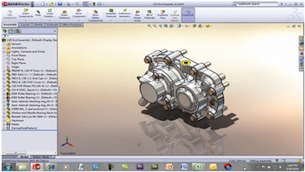SolidWorks’ 7 Tips for Windows 7 Screencast
Maximizing your efficiency by leveraging your OS better is the theme of a recent "Tips for Engineers" screencast from DS SolidWorks called "7 Tips for Windows 7."
Latest News
May 17, 2011
By Anthony J. Lockwood
Dear Desktop Engineering Reader:
Often lost in the media’s coverage of new applications is something almost as important but somewhat banal: your operating system. I’m not talking about which OS is better. Frankly, that argument approaches religious ferocity, which, albeit I am not the sharpest knife in the drawer, I’m not going to be drawn into. Rather, I mean maximizing your engineering efficiency with stuff your OS comes with that you might not know about.
 Maximizing your efficiency by leveraging your OS better is the theme of a recent “Tips for Engineers” screencast from DS SolidWorks called “7 Tips for Windows 7.” This, dear reader, is great stuff. Period.
Maximizing your efficiency by leveraging your OS better is the theme of a recent “Tips for Engineers” screencast from DS SolidWorks called “7 Tips for Windows 7.” This, dear reader, is great stuff. Period.
And it does not matter if you are a SolidWorks user or not. I found myself hitting hotkeys and trying out things while watching the video through FireFox and taking notes with OpenOffice Writer. That said, SolidWorks users have to watch this because all the examples use SolidWorks and demonstrate how SolidWorks leverages some of Windows 7’s features for improved engineering efficiency.
Anyway, so whaddya get here? Well, way more than 7 tips. After his introductory remarks, the narrator, Jeremy Regnerus, a product marketing manager at DS SolidWorks, guides you through a series of short presentations on topics like the Windows 7 task bar, searching, file management, and hotkeys. In each segment, Regnerus demonstrates multiple tips and tricks available to you because of Windows 7.
For example, during the “Applications” segment, Regnerus explains the new “record a problem” program in Windows 7. This is a built-in screen recorder program. It records the individual steps of what you’re doing, lets you annotate as you go along, and then ZIPs it all up. You can e-mail the ZIP file with its full script of your problem to whoever needs to know it. And I missed the news that the built-in Windows calculator had been enhanced with scientific and statistical functions.
One notable segment covers the Windows XP Mode, which is a must see for all of you concerned about legacy applications. Another good one shows how you can drag and drop parts from your research results directly into your SolidWorks model. And on it goes, one good tip after the other. Some are small, most all way cool.
The pace of this video is just right too. You can jot down or try out what Regnerus shows you easily, although I found myself wasting time trying to show Gina, my indifferent fat cat, what I had just learned to do. Since each vignette is small and the entire video just over 17 minutes long, it’s no big deal replaying segments.
You are bound to learn something from “7 Tips for Windows 7.” Hit the linkand enjoy.
Thanks, pal.” Lockwood
Anthony J. Lockwood
Editor at Large, Desktop Engineering
Subscribe to our FREE magazine, FREE email newsletters or both!
Latest News
About the Author
Anthony J. Lockwood is Digital Engineering’s founding editor. He is now retired. Contact him via [email protected].
Follow DE





